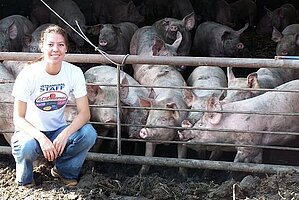Farm-scale reconnaissance of estrogens in subsurface waters

Mary Schuh is currently pursuing a Masters in Soil Science at North Dakota State University. In May of 2005, Mary completed a B.S. in English and Spanish from the University of Minnesota, Morris. She developed an interest in water management and conservation while working as a field and well inspector for the North Dakota State Water Commission during her summers as an undergrad. She is currently studying the effects of manure-born hormones applied to agricultural fields and their connection to ground water.
Email: Mary.schuh@ndsu.edu
Phone#: 701-426-7910
Fellow: Mary Schuh, Department of Soil Science, NDSU
Advisor: Dr. Frank Casey, Associate Professor of Soil Physics, NDSU
Matching Support: NDSU
Degree Progress: M.S. in Soil Science expected in 2007
Farm-scale reconnaissance of estrogens in subsurface waters
Background:
17ß-estradiol is a natural estrogen found in human and animal waste. It is the most potent natural female hormone. Low concentrations (10-100 ngL-1) have been reported to adversely affect the health of aquatic organisms; there is concern over how the hormone may affect the health of human beings. While it has been reported to dissipate rapidly in soil laboratory studies, it is frequently detected in the environment at concentrations that could potentially have adverse affects on wildlife. Land application of manures is one means of possible environmental exposure that could potentially introduce hormones into surface or ground waters.
Project Objectives:
A previous study was conducted on a swine (Sus scrofa) farm in 2003, using lysimeters that were installed 60 cm below the soil surface. These lysimeters were used to monitor the amount of 17ß-estradiol leaching through the soil of test plots treated with various types of manure. Based on known application rates and laboratory-determined fate and transport parameters, it was anticipated that most of the 17ß-estradiol would be metabolized or bound to the top 10 cm of soil. Instead, substantial amounts of 17ß-estradiol were detected at depths 60 cm and greater below the soil surface. Moreover, 17ß-estradiol was detected in the lysimeter leachate below the control plot where no manure was applied.
The objective of this study is to identify the causes of the unexpectedly high 17ß-estradiol detections found in the lysimeters and also to assess the relationship between soil hydrology, including localized groundwater flow and vertical water movement within the soil profile, and the persistence and detections of 17ß-estradiol in the soil system. It is known that the farmer injects waste material into fields near the lysimeter sites. When this manure is injected, it is potentially placed below the higher organic surface layer of the soil horizon. The soils in this area are derived from water deposited sand, are aquic and have redoximorphic features within 16 cm of the soil surface. The high sand content and low organic matter increase the potential mobility of 17ß-estradiol. Redoximorphic features indicate large fluctuations in the water table and periods of little or no oxygen. The high water tables can result in anaerobic conditions, suppressing the rate of hormone degradation. The research proposed will investigate the following hypotheses for causes: (1) There exists high levels of background 17ß-estradiol from the lagoon material the farmer injected in the field; (2) High water-table conditions cause a cool and anaerobic environment in which 17ß-estradiol persists; and (3) The ground water that contains the 17ß-estradiol is transporting exogenous hormones into the lysimeters in the soil horizon.
Progress:
A sampling strategy was formulated to allow the comparison of spatial and temporal variability of 17ß-estradiol in soil at the swine farm selected for this research. Five locations for soil cores were chosen in and around a field where liquid lagoon slurry was to be injected as fertilizer. The soil core sites were chosen based on nearness to regularly monitored wells – so soil concentrations could be easily compared to groundwater concentrations – and contact with surface conditions deemed as having potential to compromise groundwater quality, i.e. next to an uncovered compost heap, near a holding pond for lagoon slurry, and in a field injected with lagoon material. Also, samples were taken through time to observe any temporal fluctuations in 17ß-estradiol concentration due to temperature and high water tables, or manure application.
Cores were taken to the depth of the water table and separated into 6-inch increments. Pore water was extracted from each section and sent to a lab to be analyzed for concentrations of 17ß-estradiol and its main metabolite, estrone, using a combination of mass spectrometry and dual liquid chromatography (LC/MS-MS). Data from cores taken in 2006 is available. Extractions have been completed for cores taken in 2007. These samples have been prepared for analysis and results are expected by August 2007.
Dissipation study: A side experiment was completed to test the rate of dissipation of 17ß-estradiol in soil obtained from the research site. This was done, because little to no estradiol was detected in the first analyzed extracts; however, estradiol’s primary metabolic product, estrone, was being detected. A known amount of 17ß-estradiol was applied to soil columns and extracted at different times. This work was completed in May 2007. Extracts are currently awaiting analysis at the USDA-ARS lab.
Significance:
This project will provide valuable information on the behavior of 17ß-estradiol and its metabolites, allowing an assessment of the effectiveness of natural restorative processes in the environment. It will help to define the interaction of soil and ground water with respect to the retention and transport of 17ß-estradiol. Knowledge of these retention and transport processes may be useful in the development of remediation strategies. Furthermore, since 17ß-estradiol is a prototype for other endocrine disrupting chemicals (EDCs), results will contribute to a general understanding of EDCs and other possible organic contaminants.

Frank Casey
Director of the School of Natural Resources
Office: Hultz Hall 202
Telephone: 701-231-8577
Email: francis.casey@ndsu.edu


